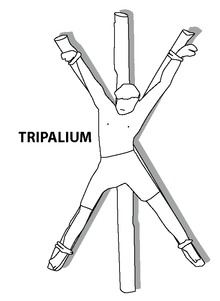Tripalium
Tripalium or trepalium (derived from the Latin roots, "tri- / tres" and "pālus" – literally, "three stakes") a Latin term believed to name a torture instrument consisting of "three stakes" (based on its literal meaning),[1][2] and commonly thought to be the source for several common modern words, including travail (French), trabajo (Spanish),[2][3] travaglio (Italian), trabalho (Portuguese), traballo (Galician), treball (Catalan), and travel, travail (English).[4] Save for the English and the Italian words, all of these mean "work". This theory has been contested.[5]

Historical background
The original usage of tripalium is still unclear. Its meaning is mainly inferred from interpretations of "three stakes".[1] The earliest references from the ancient Roman era use the term to describe a wooden structure designed to securely immobilise a large "fiery animal" (horse, oxen, cow) during examination or care. In Cicero's In Verrem ("Against Verres"), in 70 BC and 582 AD, and in an earlier text, the Council of Auxerre,[1] tripalium is used in the context of forbidding clerics to assist torture sessions, and is described as an instrument involving three stakes used to only punish slaves. The subject would be tied to the tripalium and tortured (e.g. burnt).. Historical records concerning the torture in the ancient Roman empire give many famous cases where it was applied and discussions of its legality, but they rarely indicate the means of torture[6] and do not make references to impalement.[7]
The transition from tripalium to the French technical word travail occurred in the 13th century. Travail is still used in France to describe a wooden structure used by farriers for horse care.[5] With the evolution of the French language, Tripalium could have potentially diverged into the following variants: "traveil", "traval" or "traveaul".[8] Furthermore, in the Middle Ages, tripalium described either a structure consisting of a framework of wooden beams called Trabicula, or an individual beam in the structure.[9] These trabiculae are the direct source of architecture unique to the city of Lyon, called the Traboules – transverse structures for accessing apartments.
References
- Mark Liberman (July 10, 2007). "Annals of Exoticism". Language Log.
- "trabajar". DICCIONARIO DE LA LENGUA ESPAÑOLA - Vigésima segunda edición. REAL ACADEMIA ESPAÑOLA.
- J. Cary Davis (March 1977). ""Trabaculu > Trabajo" the Case for and against". Hispania. 60 (1): 105–108. doi:10.2307/340402. JSTOR 340402.
- Winchester, Simon: The Best Travelers' Tales 2004 Archived 2005-04-05 at the Wayback Machine
- Nicholson, G.G. (1927). "Français travailler, travail". Romania. 53 (209): 206–213. doi:10.3406/roma.1927.4295.
- Dowling, Melissa Barden (2006). Clemency and cruelty in the Roman world. p. 225. ISBN 978-0-472-11515-0.
Specific details about the types and duration of torture, however, are surprisingly scarce
- Robinson, OF (2007). "Penal practice and penal policy in ancient Rome": 173 (footnote 92). Cite journal requires
|journal=(help), citing, among others, 17.3 and 27.19 of the Anecdota (Secret History) of Procopius - Dictionnaire Frédéric Godefroy, Paris F.Vieweg 1881. Dictionnaire de l'ancienne langue Française et de tous ses dialectes du IX au XVe siècle. Volume 8, page 23
- Dictionnaire Français-Latin, Félix Gaffiot Trabicula : petite poutre, poutrelle